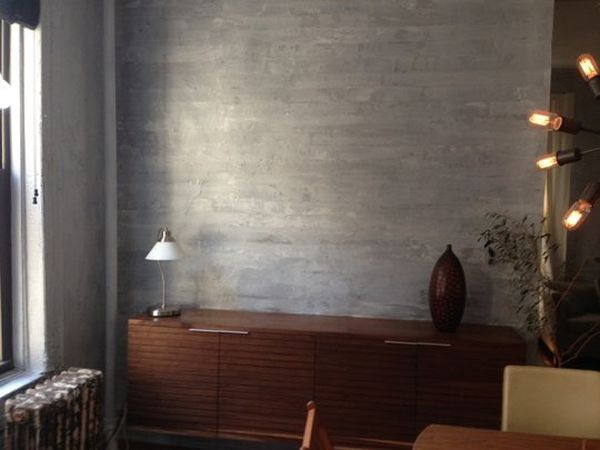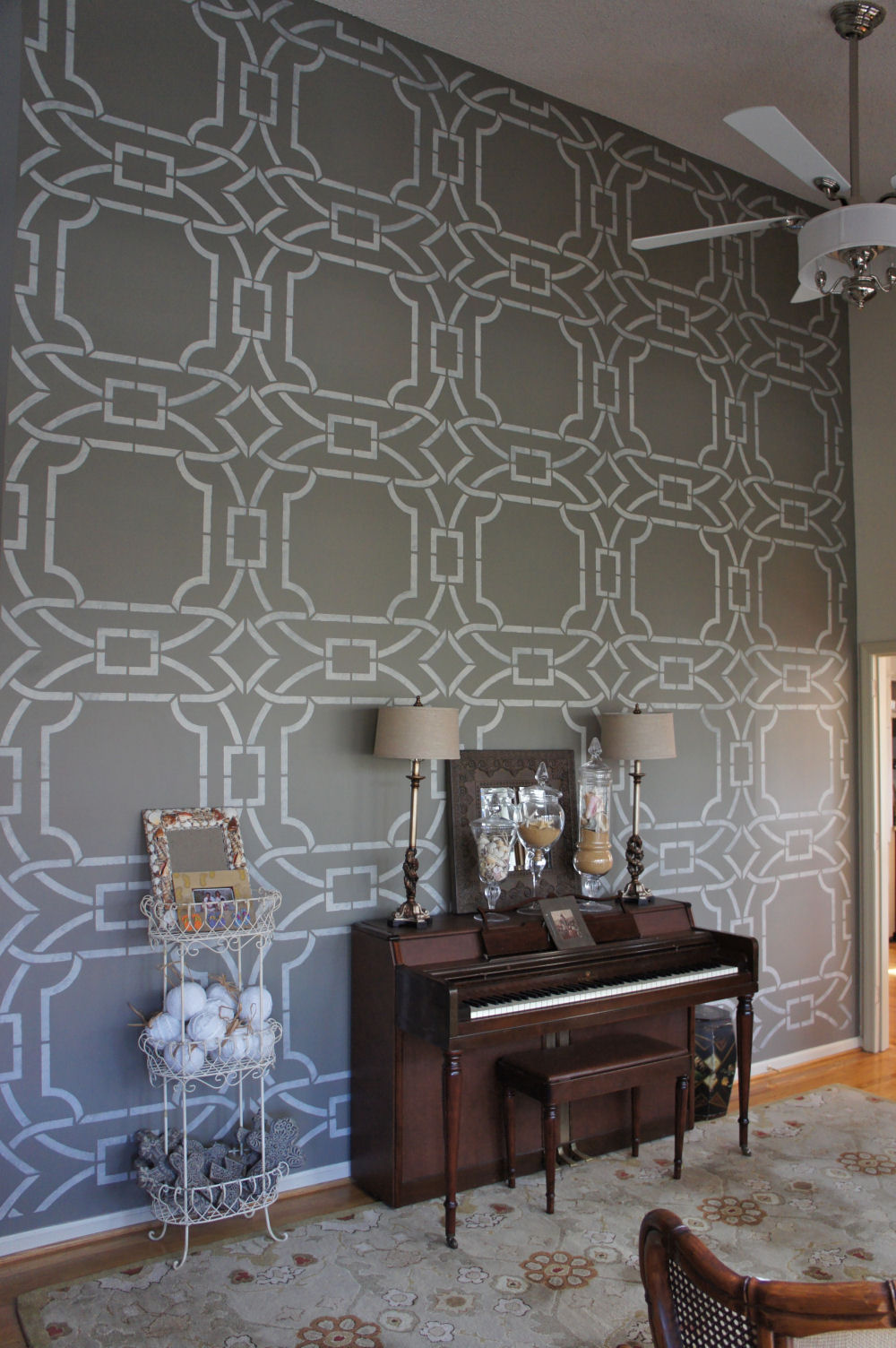Faux Painting 101: Tips, Tricks, and Inspiring Ideas for Faux Finishes
Fake painting tin exist a catchy business. The idea of "faux" in front of anything means that it's a fake, a copy, a tacky-ish version of the existent thing. While it's untrue that "simulated" things are ever inferior to the existent deal, it's important to take intendance in creating a beautiful finished product. Imitation painting finishes in domicile décor are no exception to this dominion. Do information technology the right way to get results you lot'll be proud of.
 View in gallery
View in gallery Ultimately, faux painting (or false finishing) is a term used to draw a decorative paint terminate that replicates the appearance of another cloth. Marble, wood, and rock are common materials to exist replicated with false finishing.
 View in gallery
View in gallery Nosotros've put together this full general guide to faux painting and faux finishes on the interior surfaces of your dwelling house. In about cases, paint or glaze is used for a unique, stand up-out effect. We promise you discover the information useful.
Concrete-ing.
 View in gallery
View in gallery  View in gallery
View in gallery (Yes, that is a made-up give-and-take. Information technology means, "Painting a Concrete Faux Finish.") For a soft, gimmicky look and feel to your fake-finished walls, consider replicating the look of physical by following this total tutorial. In a nutshell, the procedure involves random however strategic incorporations of white, grey, and black paint and glazing with a nine-inch plaster blade.
Graining.
 View in gallery
View in gallery With faux bois beingness a contempo hot trend in interiors, graining might be the way to become in imitation finishes. Purchase a graining tool (specially designed for creating a wood-grain finish), then drag information technology gently down or across a wet glazed or painted surface. Exist sure to rock the graining tool every bit you lot get in random, varied spots, to mimic the natural form of wood grain.
Strie Painting.
 View in gallery
View in gallery Strie is a faux cease painting technique that is used to create soft streaks of color. When the streaks are fatigued onto the wall paint, the final effect is something soft that resembles material. Apply a pigment/glaze combo using a roller and vertical strokes, then drag a long-bristled brush advisedly downwardly through the paint/glaze.
Sponging.
 View in gallery
View in gallery The use of a sponge in faux painting has been around for years; it'south a staple in the imitation finishing world. Lightly dip a dry out sponge into the paint and gently button it onto the surface y'all're working with. The fundamental to sponging is to practise multiple layers, each very calorie-free, to build up to the color density yous're later on. You lot want the sponged colors to exist as even equally possible beyond the entire surface. Consider using slightly different shades of the same color for a subtle depth in your finished false surface.
Denim Painting.
 View in gallery
View in gallery Apply the shade of indigo that speaks to you (read: your favorite jeans color) or similar to create a denim consequence on your walls. Castor in vertical and horizontal strokes to mimic the cross-stitching of denim for a funky, modern twist on faux stop painting.
Bricking.
 View in gallery
View in gallery Create the illusion of bricks on any surfaces past faux painting them on. (This technique could come in handy for a mannerly patio finish or an "exposed" brick wall, if that's your thing.) Employ a serrated kitchen knife to cut a few synthetic sponges into a brick shape and size, and then space and mucilage them onto plywood. Employ a roller to paint brick-colored paint onto the stamp sponges, the printing onto surface. Repeat until surface is covered in "bricks."
Ragging.
 View in gallery
View in gallery Crumple a damp fabric (or a plastic or paper pocketbook), then press it randomly into the wet coat or paint on your wall to create a streaked simulated effect. Be certain to rinse or swap out the coat-soaked rag regularly.
Rag-rolling.
 View in gallery
View in gallery Crumple a rag, then roll it into a worm-like shape. Whorl it down the painted or glazed wall surface for a subtle false effect. For more than drama, effort calculation the paint or coat onto the rag itself earlier rolling on the wall. (Annotation: In this photo, shale blue was rag-rolled on elevation of a Baltic greenish base of operations, then antique glaze was sponge-rolled over both.)
Marbleizing.
 View in gallery
View in gallery Existent marble is the crème de la crème, of course, but if you aren't in a position to take Carrera marble or something as beautiful, consider painting a realistic faux version. This stride-past-step tutorial provides photos and tips for achieving a high-stop look with merely a few careful strokes of paint.
Leathering.
 View in gallery
View in gallery Similar to rag-rolling, recreate the luxe look of leather on your walls with chamois. Get-go by painting the base color on the walls, and so roll and tie several pieces of chamois together. Use coat onto the wall over the base glaze by rolling the chamois gently. The soft texture of chamois results in the soft, mottled look reminiscent of distressed leather.
Stippling.
 View in gallery
View in gallery Go your hands on a stippling brush (information technology's a brush that's peculiarly designed for faux finishing, typically with stiff, short bristles), then push the ends of it onto your wet glazed or painted surface. This creates a very subtle, finely textured, almost soft fake terminate. Be sure y'all don't drag the stippling castor; only use an up-down movement for best results.
Stenciling.
 View in gallery
View in gallery Use painter'southward tape to attach the stencil of your choice to the surface you lot're faux finishing. Using an up-down (or, rather, in-out for a wall) motion, employ your pigment with a stenciling brush. Remove the stencil when pigment is still wet, and attach it to the side by side spot, using a level if necessary to go on things squared up. Repeat.
Plastering.
 View in gallery
View in gallery Spread plaster of Paris (or Venetian plaster) with a putty knife over your surface to create thicker texture, then use pigment and/or glaze to emphasize the texture gradients. This is a lovely mode to recreate an Old Globe feel on walls and ceilings.
Pitiful.
 View in gallery
View in gallery Also known equally "shabby chic," distressed finishes accept had quite a loyal following over the past several years. When you're looking to use distressing in your faux finish, consider where the natural wear and tear would be on the space. Often, the edges, sides, or handled areas would see the nigh deplorable over time. After painting in your chosen color(s), lightly sand these areas down until you achieve the desired effect. Stop information technology off with stain, wax, or another protective blanket.
Dragging.
 View in gallery
View in gallery If you lot like the wait of seagrass wallpaper, you might have good luck with the imitation finish dragging technique. Concord a dragging castor (specially designed with long bristles) at a low bending, then pull it down or across the glazed or painted surface in long, smooth strokes. The final result is a horizontal or vertical coarse-lined, textured end.
 View in gallery
View in gallery Have you seen whatsoever other false finishes that you've loved? How about this faux finish on painted silver leaf paper?
Source: https://www.homedit.com/faux-painting-101/
0 Response to "Faux Painting 101: Tips, Tricks, and Inspiring Ideas for Faux Finishes"
Post a Comment